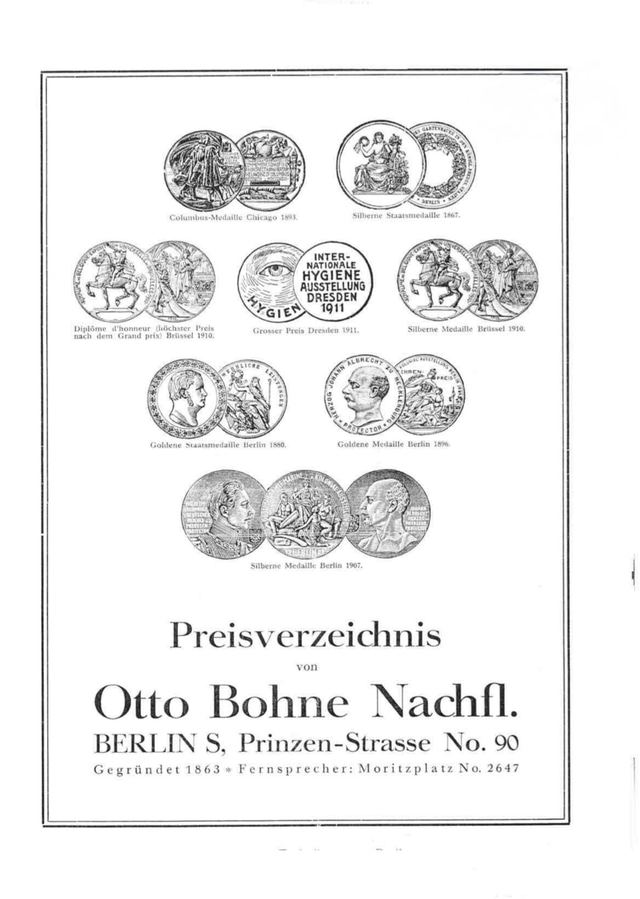
Otto Bohne was a 19th-century German master mechanic who specialized in the manufacture of aneroid barometers. It is known that at the beginning of his career, he trained and worked in Paris at the renowned firm Naudet, which produced the so-called "holosteric" barometers (PHBN). After gaining experience in Paris—including a period working at Lerebours et Secretan—Bohne returned to Germany and, in 1863, founded his own workshop in Berlin. His early barometers closely followed the French models developed by Naudet.
However, Otto Bohne’s most significant contribution to barometer technology was the introduction of bimetallic temperature compensation in aneroid construction. Around the time he founded his firm (mid-1860s), he developed a mechanism using bimetallic components to compensate for the effect of temperature on the elasticity of the aneroid capsule. This innovation significantly improved the accuracy and stability of the instrument’s readings under varying ambient temperatures. Contemporary observers noted that Bohne's aneroid systems were as accurate as the famed Naudet barometers, with his thermal compensation effectively neutralizing temperature-related deviations.
Initially, Otto Bohne's production focused mainly on scientific and technical applications. His barometers and altimeters were used by meteorologists, geographers, and other specialists. For instance, the explorer Hans Meyer listed Otto Bohne’s workshop among the best suppliers of instruments for expeditions. Over time, the product range expanded: in addition to precision instruments for laboratories, the firm began producing more accessible barometers for general use—both wall-mounted and portable devices for domestic environments.
By the end of the 19th century, the enterprise also began producing related meteorological instruments. Notably, Otto Bohne manufactured pressure recorders (barographs) and specialized altimeters for aeronauts. At one exhibition, the firm presented an aneroid recorder (barograph) and a large-scale educational model barometer. By 1910, the product line included statoscope-equipped barometers, barographs, and thermographs—a complete set of instruments for atmospheric observation. Thus, the workshop had grown into a full-fledged precision mechanics enterprise producing a wide array of aneroid devices.
Particular attention should be given to the connections and collaborations that influenced the company’s development. In fact, Bohne's manufacturing efforts were rooted in close contact with the aforementioned French innovators. It could be said that Otto Bohne became a kind of German branch of the holosteric barometer tradition, adapting and improving it (notably by adding the thermal compensation feature). Furthermore, the company actively engaged with the scientific community: its instruments were tested at the State Physical-Technical Institute and used in aerological research. In the 1880s, the Berlin Society for the Promotion of Aeronautics used Otto Bohne’s barometers during a series of scientific balloon flights. These projects confirmed the high quality of the instruments and established the firm’s reputation as a reliable supplier for extreme conditions.
The exceptional quality of Otto Bohne’s devices was repeatedly demonstrated at national and international exhibitions, where the firm received awards and recognition. As early as 1879, the company participated in the Berlin Industrial Exhibition. At the 1893 World’s Columbian Exposition in Chicago, its barometers were displayed as part of the German exhibit. In Germany, the firm presented its products at major exhibitions toward the end of the century, such as the Berlin Industrial Exhibition of 1896. Over the decades, Otto Bohne received official awards. In 1899, his products earned a prize in Berlin, and at the 1902 Düsseldorf exhibition, the company was awarded the Prussian State Medal. These honors reflected state-level recognition of the master’s achievements.
After Otto Bohne’s passing around 1906, the business was taken over by new owners: Louis Kurth and Otto Kohlmann, who retained the prestigious name by adding the word Nachfolger (“Successors”). The company continued its work under the name Otto Bohne Nachf., maintaining its original specialization. The successors upheld the brand’s high quality and spirit of innovation. In the pre-war years, they developed instruments for new fields; for example, Bohne altimeters were used in the emerging aviation industry. During World War I, the company supplied barometric altimeters for German military aviation. Notably, Bohne aviation barometers with zero-correction statoscopes were installed in bombers between 1914 and 1916.
The company continued its operations for some time after the war. The last recorded address of Otto Bohne Nachf. was 90 Prinzenstraße, Berlin, as of 1927. It is assumed that the company ceased operations in the late 1920s, likely due to the economic difficulties of the time and increasing competition. Nevertheless, Otto Bohne’s legacy in the history of scientific instrumentation remains significant. His temperature-compensated aneroids became prototypes for future barometer designs, and the company trained a new generation of craftsmen who continued the traditions of precision mechanics in Berlin.
Today, aneroid barometers and barographs bearing the stamp “Otto Bohne – Berlin” or “O. Bohne Nachf.” are valuable museum and private collection items, reminding us of an era when German precision merged with French inventiveness in an instrument designed to measure the “weight of the air.”